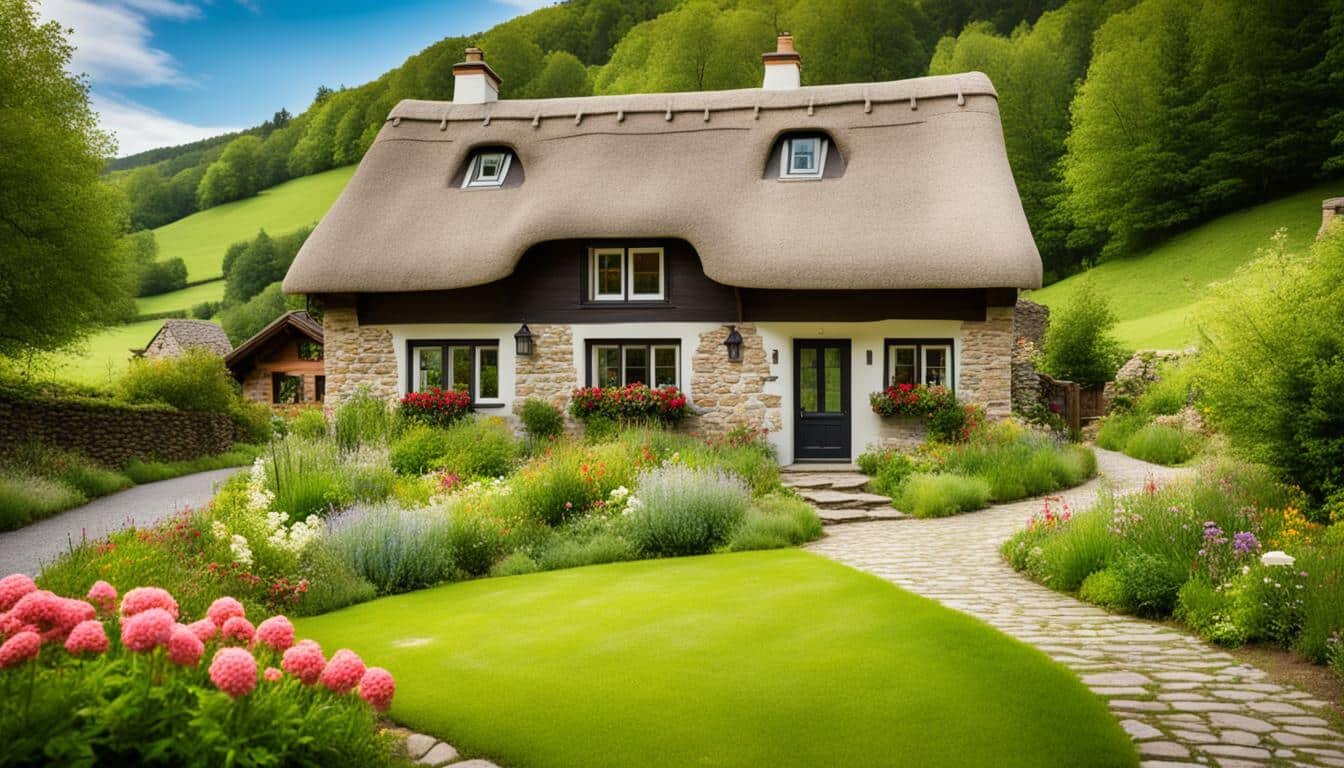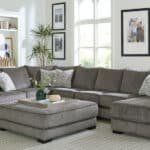The merging of smart home tech with traditional architecture is changing our living spaces. This mix of old and new creates a balance. It connects the beauty of classic designs with today’s modern tech innovations.
Old designs, like New England cottages to Southern mansions, are known for their beauty. They tell the story of their communities. But, with technology changing fast, we wonder how to keep the charm of old styles while using new, smart gadgets.
Architects and designers face an interesting challenge. They’re finding ways to add smart tech to old building styles. They’re using new tools to make homes that are stylish and smart, while being kind to the planet.
This mix of old and new is changing how we live. Imagine being able to control your home’s lights just by talking. Or, having a house that knows when you’re coming home and adjusts the temperature for you. The blend of beautiful old styles with super smart tech is coming together.
Key Takeaways
- The integration of smart home technology with traditional architecture is reshaping the way we design and experience living spaces.
- Architects and designers are exploring innovative ways to blend modern conveniences with the timeless aesthetic and cultural heritage of traditional building styles.
- Smart home features, such as automation, connectivity, and energy efficiency, are being seamlessly incorporated into the architectural fabric, creating a new frontier of living.
- The convergence of tradition and technology is transforming the way we perceive and interact with our built environment.
- The integration of smart home technology with traditional architecture offers a unique opportunity to create living spaces that are both technologically advanced and respectful of architectural heritage.
Embracing Technology in Traditional Architecture
The mix of smart home tech and traditional design is changing how we live. People are merging historic beauty with modern digital efficiency. This mix is changing our relationship with the places we live in.
The Shift Towards Smart Living
Today’s homeowners and designers want to add smart features smoothly. Things like light and climate control, security, and entertainment are going high-tech. This shift means homes in the 21st century are becoming even more intelligent spaces.
Addressing Modern Lifestyle Demands
Smart tech is becoming more common because it meets modern needs. With busy lives and a focus on green living, smart systems offer convenience and help the planet. This change is making daily life easier and more eco-friendly.
The Essence of Traditional Architecture
Traditional architecture deeply values cultural heritage and timeless design. Its principles have influenced building style for centuries. They showcase the different traditions and identities of societies worldwide.
These days, it’s important to keep the spirit of traditional architecture alive. This ensures we don’t lose the beauty, usefulness, and cultural importance of old buildings, even as new tech takes over.
Preserving Cultural Heritage
Traditional architecture is how a community shows its cultural identity. It carries the values, beliefs, and style passed through the years. There’s a story in every design, from the classic styles of Europe to the nature-focused architecture in Japan.
By saving these old buildings, we protect a rich part of human culture. It helps us understand and value the different traditions around the world.
Timeless Design Principles
Traditional architecture follows design rules that always work well. These principles focus on being useful, eco-friendly, and fitting into nature. They use local materials and smart ways to cool or heat a building.
In today’s world, these old lessons are more important than ever. They can guide us in tackling big issues like urban life problems and climate change. By mixing these lessons with new technology, we can create homes that are both modern and classic.
Seamless Integration of Smart Home Systems
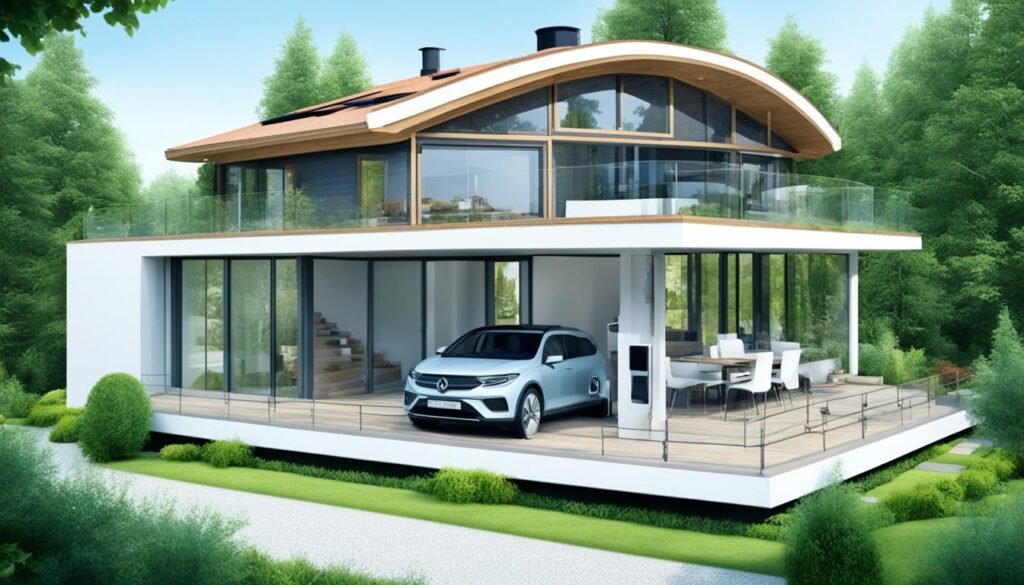
Traditional architecture is joining the digital world, making smart home systems essential. Architects and designers pay close attention to this blend. They are careful to keep the new tech in harmony with the classic look and feel of old buildings.
Interoperability and Connectivity
To fit smart systems into old buildings, high interoperability and connectivity are needed. It’s crucial for architects to pick smart home parts that work together. They work closely with tech leaders to make sure everything fits while keeping the old building’s charm.
User-Centric Design Approach
Integrating smart home systems isn’t just about tech; it’s about people. This means knowing what homeowners want and need. Architects and designers focus on creating spaces where people and their homes work together seamlessly. This approach adds modern comfort without losing the feel of traditional design.
Scalability for Future Advancements

Technology is growing fast, blending smart home systems with traditional homes for the future is key. We must ensure these homes can grow and change with new tech.
Updating and adding to smart home systems smoothly is crucial. This keeps the systems useful and up-to-date. Architects and designers team up with tech experts. They make sure the base of these smart homes is ready for what’s coming next. This helps homeowners to easily add new features as they’re developed.
Focusing on scalability helps to keep traditional homes ready for tech changes ahead. This makes them strong and able to meet future needs. It boosts both the home’s value and the owner’s satisfaction over time.
| Feature | Benefit |
|---|---|
| Modular smart home system design | Allows for seamless integration of new technologies and devices without extensive retrofitting |
| Wireless connectivity and protocols | Enables easy expansion and reconfiguration of smart home systems |
| Open-source and interoperable platforms | Facilitates the integration of diverse smart home products and services |
| Adaptable infrastructure and wiring | Supports the installation of new sensors, actuators, and control systems |
Choosing a scalable plan for smart homes keeps them valuable and flexible. It offers a lasting smart living experience to the homeowners.
Sustainable and Energy-Efficient Strategies
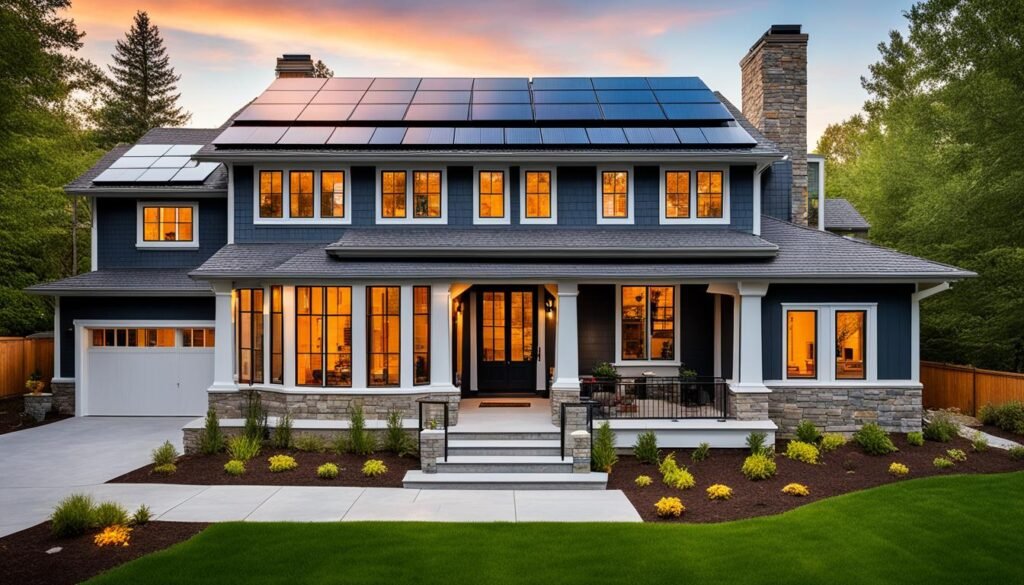
Traditional architecture is now all about smart home tech and being greener. This change is important. It lets people lower their home’s impact on the planet. They also save money over time.
Reducing Environmental Impact
Smart homes use sensors to be more efficient. They watch and adjust how much energy or water is used. This means less waste and a home that’s better for the planet.
Smart homes can make their own clean power. They do this with things like solar panels. They also adjust the temperature and humidity inside to save energy.
Long-Term Cost Savings
Using smart tech can save a lot of money. These systems can track how much energy is used. Then, they give tips to help reduce that use.
| Traditional Architecture | Smart Home Integration |
|---|---|
| Reliance on manual adjustments for energy management | Automated and adaptive energy optimization |
| Inefficient use of resources leading to higher utility bills | Reduced energy consumption and utility costs |
| Limited ability to integrate renewable energy sources | Seamless integration of renewable energy solutions |
| Reactive maintenance and repairs | Proactive monitoring and predictive maintenance |
Smart technologies help save money in the long run. They cut down on energy bills and make home maintenance easier. This, plus helping the planet, shows why smart, green strategies in homes are so important.
Emergent Design Challenges
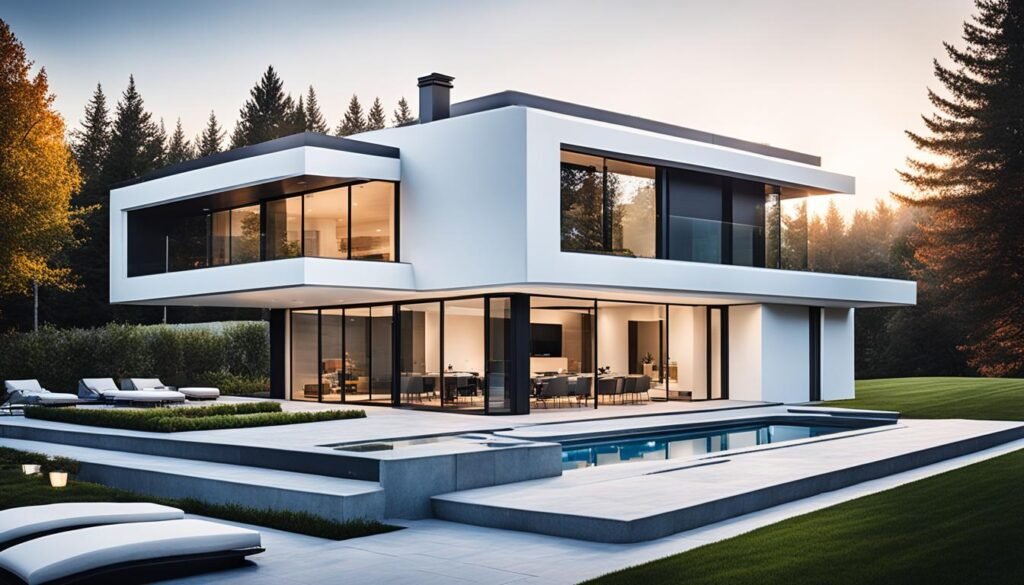
Smart home technologies are being mixed with traditional architecture more than ever. Yet, this merger brings several new challenges. Designers and architects must carefully consider these issues to ensure homes are both safe and harmonious for residents.
Data Security and Privacy
The rise of connected devices has made data security and privacy big concerns. It’s key for architects and designers to team up with tech experts. Together, they can create strong security that keeps private information safe. This means using safe ways to communicate, strong encryption, and tight control over who can access what data.
Adapting to Rapid Technological Changes
The smart home world is always changing with new devices and tech appearing all the time. To keep up, architects and designers must be ready. They should make home systems that can change without losing their basic design. This way, homes won’t just be smart now but also in the future.
| Design Challenge | Key Considerations |
|---|---|
| Data Security and Privacy |
|
| Adapting to Rapid Technological Changes |
|
Enhancing Living Experiences with Smart Solutions
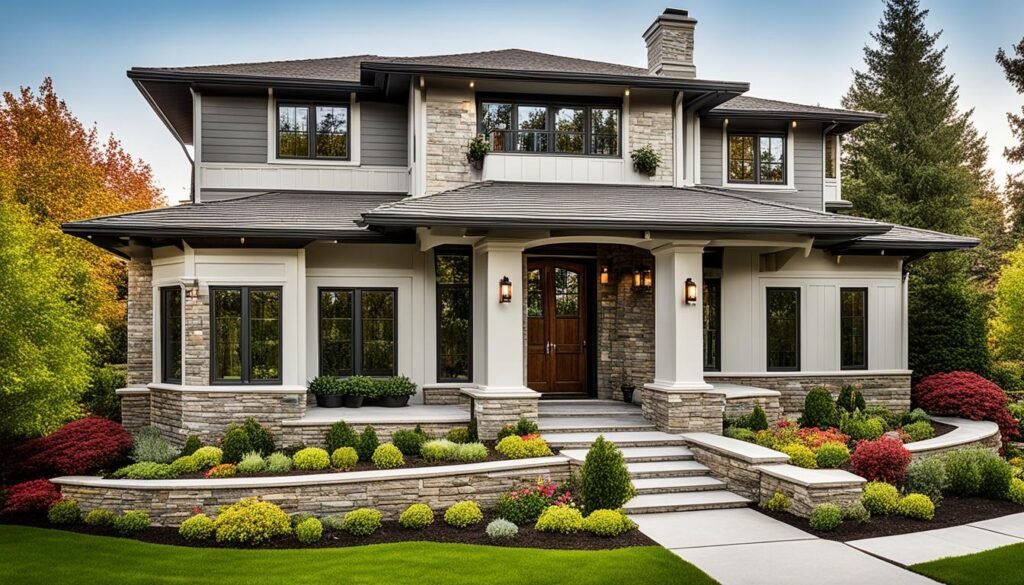
Smart home technology is changing the way we live. It’s focusing on making life better for everyone, mostly through better lights and safer homes.
Lighting Automation
Smart lights are changing how we use light at home. They adjust on their own, using sensors and tech. This saves energy and creates the perfect lighting for every moment.
You can control these lights with your phone or your voice. Change the brightness, color, or use presets for different scenes. It makes your home just right for any situation.
Smart Security and Access Control
Security is also getting smarter. Now, you can have locks and cameras that talk to each other. This gives you better safety and control.
You can keep an eye on your home from anywhere. Lock your doors with a tap. See alerts or watch live video with cameras. It helps you feel secure, even when you’re out.
These smart systems connect with other tech in your home. Everything works together to make life easier and safer. It all adds up to a better way of living.
traditional architecture
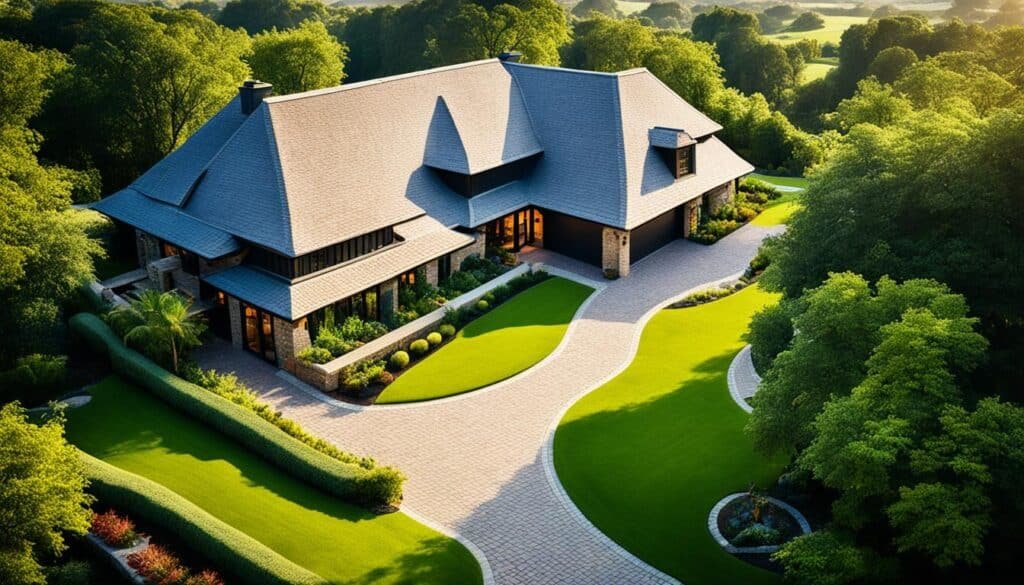
Smart home tech is changing our homes. But, blending it with traditional beauty and culture is key. It’s a balance architects and designers must find.
Blending Modern Convenience with Timeless Aesthetics
Adding smart systems to classic homes needs care. It should keep the beauty and character of old buildings. This way, homes can be modern and efficient and still feel traditional.
Preserving Architectural Heritage
Keeping the past alive is also crucial. As smart tech grows, we need to ensure it fits without changing the traditional feel. This includes picking the right materials and design. The goal is for the old beauty to remain.
Accessible Living with Intelligent Technology
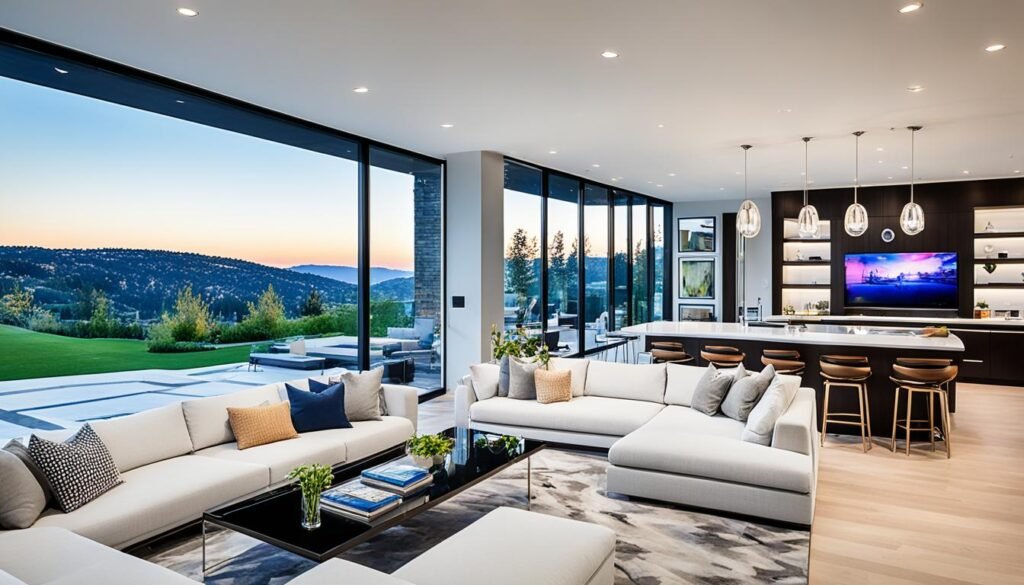
Smart home technology is changing how we live, making our homes more welcoming and inclusive. Architects and designers use smart systems to meet the needs of everyone, no matter their abilities. This ensures that homes are made to welcome people with different physical, cognitive, and sensory abilities.
Inclusive Design for All
Inclusive design is key when adding smart home tech. It makes sure that homes are not just filled with cool tech, but also easy to use for everyone. This includes those with disabilities, older folks, and anyone with special needs. Features like voice commands and easy-to-use interfaces make living better for all.
Proactive Accommodation of Diverse Needs
Smart tech lets architects and designers think ahead and plan for everyone’s needs. They can set up lights and climate systems that adjust to make life easier for those with physical or sensory issues. Security and communication systems can help those with special needs feel safer and more connected in their homes.
| Feature | Benefit for Accessible Living |
|---|---|
| Voice-activated controls | Enables individuals with physical disabilities to easily operate home systems without the need for manual input |
| Adjustable lighting and temperature | Provides customizable settings to accommodate sensory needs and promote comfort for all occupants |
| Integrated security systems | Enhances safety and independence for residents with cognitive or hearing challenges |
| Intuitive user interfaces | Ensures seamless interaction with smart home features, regardless of individual abilities |
Bringing smart tech together with inclusive design makes living spaces that improve everyone’s life. This happens by meeting the unique needs and abilities of every occupant. Smart tech isn’t just about gadgets; it’s about making a home that’s truly for everyone.
Also Read : Elegant Entertaining: Sophisticated Dining Room Design Ideas
Seizing Opportunities in Smart Home Design
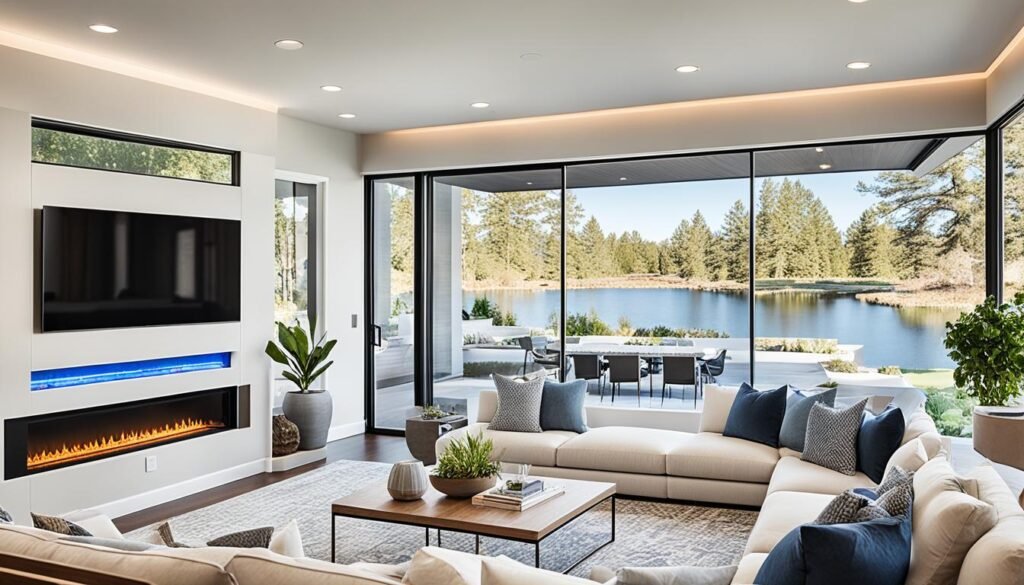
Smart home technology is blending with traditional architecture in new ways. This blend opens up exciting chances for architects and designers. They now have the power to make living spaces that are more flexible. These spaces meet the various needs and wants of people who live there.
Flexible Living Spaces
This mix allows home designs to change easily based on the residents’ needs. Think of homes with furniture that can move, rooms that transform, and smart systems that adjust as needed. This flexibility lets people make their homes truly their own. It helps create a sense of belonging and happiness.
Expanding Customer Base
Integrating smart features into homes is also a smart business move. It draws in more clients for architects and designers. There’s a big market for homes that are high-tech yet beautiful. This approach appeals to both the young and the old. It opens doors for new business and shapes the future of home design.
Industry Collaboration for Smart Home Integration
The merging of smart home tech with traditional architecture is changing the game. It’s showing us how crucial it is for many areas to work together. This includes architects, builders, tech experts, and those who set the rules. They must all join forces. This helps tackle the problems and make the most of the new chances. Creating common rules and guidelines is a big part of this group effort. These rules mean different smart home parts and old building styles can work together smoothly. This makes smart homes better for people and ensures they’ll continue to grow over time.
Teams working together also share what they know. This keeps architects and designers updated on new smart home tech. It helps them add cool, new tech that fits well with how things look and work in traditional buildings.
It’s also key for architects, city planners, and local governments to talk. They need to ensure smart homes meet all the rules, like building codes and keeping a place’s unique history. This full-team approach makes sure smart tech doesn’t change the look and feel of a place too much but keeps it modern enough for today’s life.
And let’s not forget about you, the future homeowner. You play a big part in how smart homes are designed. Architects and tech experts include your wishes from the start. This way, the house tech not only fits with the older style but also makes the whole living experience better for you.
Conclusion
We’ve looked at how smart home tech mixes with classic design in this article. It’s changing how we see our homes and live in them. This blend brings together the ease of modern tech with the beauty and history of old building styles. It meets the changing needs of our lives today.
Bringing smart tech and old ways together has big benefits. It makes homes not just look good but work better, use less energy, and can change with the times. This special mix lets people use new tech without losing the old charm, keeping their cultural roots strong.
To make smart homes work well, everyone needs to pitch in. Architects, designers, tech companies, and you as a homeowner all need to work together. This team effort will overcome challenges and make the most of this new trend. It will lead us to homes that are both smart and good for the earth, a new peak of living quality.
FAQs
Q: What is the relationship between smart home technology and traditional architecture?
A: Smart home technology is increasingly being integrated into traditional architecture to enhance the functionality and convenience of the spaces while maintaining the aesthetic appeal of the traditional building designs.
Q: How does modern architecture influence the integration of smart home technology?
A: Modern architecture often incorporates advanced building materials and innovative design features that seamlessly support the integration of smart home technology, allowing for a harmonious blend of modern convenience with traditional style.
Q: What role do architects play in integrating smart home technology into traditional buildings?
A: Architects play a crucial role in designing and adapting traditional buildings to accommodate smart home technology, ensuring that the functionality and aesthetics align seamlessly with the overall architectural vision and modernism.
Q: Can smart home technology be integrated into vernacular architecture?
A: Yes, smart home technology can be effectively integrated into vernacular architecture, combining modern amenities with the rich cultural and historical aspects of traditional building styles with urbanism.
Q: How does the use of smart home technology impact traditional architectural styles?
A: The integration of smart home technology into traditional architectural styles can enhance the overall appeal and functionality of the spaces, offering a contemporary twist to traditional design elements.
Q: What factors should be considered when merging smart home technology with traditional architectural design?
A: When integrating smart home technology with traditional architectural design, factors such as building materials, spatial layout, and aesthetic harmony need to be carefully considered to ensure a seamless blend of modern innovation with traditional charm.
Q: In what ways does smart home technology complement classical architecture?
A: Smart home technology can complement classical architecture by enhancing the building’s efficiency, security, and comfort levels without compromising the timeless elegance and grandeur of classical architectural elements.
